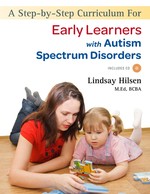 by Lindsay Hilsen MEd, BCBA
by Lindsay Hilsen MEd, BCBA
This book will equip teachers, therapists and parents with a thorough and comprehensive program to help ensure the young learners in their care are achieving developmental goals and are able to reach their full potential as they grow.
Full Description:
Applied Behavior Analysis (ABA) is recognized as one of the most effective ways to teach children with autism and studies have shown that the earlier the interventions take place the more likely they are to have a profound, positive impact on a child's later development.
Using the latest research into best practice for children with autism, this curriculum gives a clear outline on what to teach and how to teach it utilizing the principles of ABA. The book is divided up into three sections, each with built-in data collection, and features a CD with all the material in the book so you can print off the section you are working on. The Assessment section allows you to initially measure the child's level of learning and then track their progress over time. The Curriculum section covers nearly ninety crucial steps in a child's development spread over twelve chapters that each focus on a different pivotal area, such as 'Motor', 'Expressive' and 'Academic' Programs. These are broken down into simple tasks that can be taught and monitored easily. The final Mastered section guarantees that progress can be maintained by checking that learnt skills continue to be retained. Generalization assessment is included throughout to make sure the child has adapted to using the skills in a variety of settings.
This book will equip teachers, therapists and parents with a thorough and comprehensive program to help ensure the young learners in their care are achieving developmental goals and are able to reach their full potential as they grow.
2011, 279.4mm x 216mm / 11in x 8.5in, 416pp
Dedication Page. Acknowledgements. Introduction. About the Author. 1. ASSESSMENT. 1.1. Choosing programs to work on. 1.2. Assessment Directions. 1.3. Total Percentages.1.4. Assessment Section Example. 1.5. Quiet Hands. 1.6. Attending.1.7. Responds to Name. 1.8. Eye Contact. 1.9. Pointing Program. 1.10. Responds to Various Directions to Identify an Object/Picture/Item. 1.11. Wait Program.1.12. Transition. 1.13. Desensitization to Touch. 1.14. Desensitization to the Dentist. 1.15. Desensitization to the Doctor's Office. 1.16. Desensitization to Getting Haircuts. 1.17. Clean Up.1.18. Gross Motor Imitation. 1.19. Motor Imitation. 1.20. Fine Motor Imitation. 1.21. Oral Motor Imitation. 1.22. Color Between the Lines. 1.23. Copy Straight Lines. 1.24. One Step Direction. 1.25. Two Step Directions. 1.26. Receptive Identification of Pictures. 1.27. Receptive Identification of Objects. 1.28. Receptive Identification of Body Parts. 1.29. Receptive Identification of Articles of Clothing. 1.30. Receptive Identification of Familiar People. 1.31. Receptive Identification of Emotions. 1.32. Receptive Identification of Community Helpers. 1.33. Receptive Identification of Environmental Sounds. 1.34. Expressive Identification of Pictures. 1.35. Expressive Identification of Objects. 1.36. Expressive Identification of Body Parts. 1.37. Expressive Identification of Articles of Clothing. 1.38. Expressive Identification of Familiar People. 1.39. Expressive Identification of Emotions. 1.40. Expressive Identification of Community Helpers. 1.41. Expressive Identification of Environmental Sounds. 1.42. Receptive Identification of Actions. 1.43. Expressive Identification of Actions. 1.44. Imitates Actions of Others. 1.45. Imitation of Two Step Actions. 1.46. Pretends to do an Action. 1.47. Point to Communicate. 1.48. Yes/No. 1.49. Manding. 1.50. Requests with Eye Contact. 1.51. Gets Attention of Others. 1.52. Says Bye. 1.53. Says Hi. 1.54. Imitation of Sounds. 1.55. Uses different words to request. 1.56. Common Animal Intraverbals. 1.57. Common Intraverbals. 1.58. Daily Activity Intraverbals. 1.59. Social Questions. 1.60. Puzzle. 1.61. Shape Sorter. 1.62. Plays By Self. 1.63. Various Methods of Play. 1.64. Ball Play. 1.65. Plays with Indoor Toys. 1. 66. Outdoor Play. 1.67. Uses Language While Playing. 1.68. Sings Songs. 1.69. Games. 1.70. Pretend Play. 1.71. Drinks from a Cup. 1.72. Uses a Spoon. 1.73. Uses a Fork. 1.74. Getting Dressed: Shoes. 1.75. Getting Dressed: Pants. 1.76. Getting Dressed: Shirt. 1.77. Wash Hands. 1.78. Dry Hands. 1.79. Match Identical Picture to Picture. 1.80. Match Identical Object to Object. 1.81. Match Object to Picture. 1.82. Sort Identical Items. 1.83. Sort Non-Identical Items. 1.84. Receptive Identification of Colors. 1.85. Expressive Identification of Colors. 1.86. Receptive Identification of Shapes. 1.87. Expressive Identification of Shapes. 1.88. Receptive Identification of Upper Case Letters. 1.89. Receptive Identification of Lower Case Letters. 1.90. Expressive Identification of Upper Case Letters. 1. 91. Expressive Identification of Lower Case Letters. 1.92. Rote Count. 1.93. Count Objects. 1.94. Receptive Identification of Numbers. 1.95. Expressive Identification of Numbers. 2. CURRICULUM. 2.1. Curriculum Directions. 2.2. Curriculum Section Example. 2.3. BASIC PROGRAMS. 2.3.1. Quiet Hands. 2.3.2. Attending. 2.3.3. Responds to Name. 2.3.4. Eye Contact. 2.3.5. Pointing Program. 2.3.6. Responds to Various Directions to Identify An Object/Picture/Item. 2.4. BEHAVIOR PROGRAMS. 2.4.1. Wait Program. 2.4.2. Transition. 2.4.3. Desensitization to Touch. 2.4.4. Desensitization to the Dentist. 2.4.5. Desensitization to the Doctor's Office. 2.4.6. Desensitization to Getting Haircuts. 2.4.7. Clean Up. 2.5. MOTOR PROGRAMS. 2.5.1. Gross Motor Imitation. 2.5.2. Motor Imitation. 2.5.3. Fine Motor Imitation. 2.5.4. Oral Motor Imitation. 2.5.5. Color Between the Lines. 2.5.6. Copy Straight Lines. 2.6. RECEPTIVE PROGRAMS. 2.6.1. One Step Direction. 2.6.2. Two Step Directions. 2.6.3. Receptive Identification of Pictures. 2.6.4. Receptive Identification of Objects. 2.6.5. Receptive Identification of Body Parts. 2.6.6. Receptive Identification of Articles of Clothing. 2.6.7. Receptive Identification of Familiar People. 2.6.8. Receptive Identification of Emotions. 2.6.9. Receptive Identification of Community Helpers. 2.6.10. Receptive Identification of Environmental Sounds. 2.7. EXPRESSIVE PROGRAMS. 2.7.1. Expressive Identification of Pictures. 2.7.2. Expressive Identification of Objects. 2.7.3. Expressive Identification of Body Parts. 2.7.4. Expressive Identification of Articles of Clothing. 2.7.5. Expressive Identification of Familiar People. 2.7.6. Expressive Identification of Emotions. 2.7.7. Expressive Identification of Community Helpers. 2.7.8. Expressive Identification of Environmental Sounds. 2.8. ACTION PROGRAMS. 2.8.1. Receptive Identification of Actions. 2.8.2. Expressive Identification of Actions. 2.8.3. Imitate
Stock: usually ships in 7-10 business days!
|